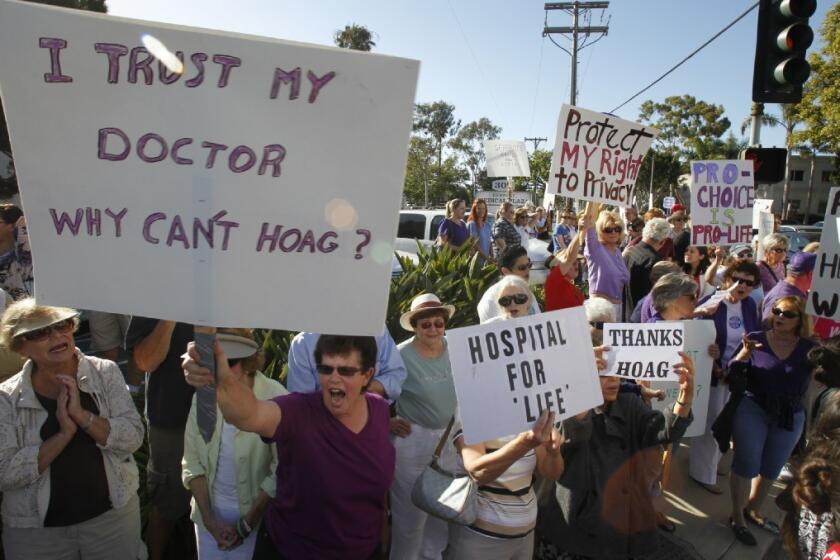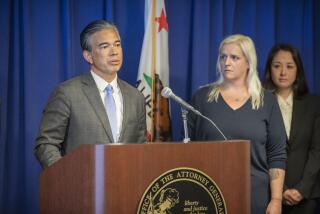Column: Sick of religious limits on care, a hospital seeks to end partnership with Catholic system

- Share via
There may not be many reasons for optimism in American healthcare just now, but one glimmer of hope has emerged in Orange County, Calif., where a prestigious hospital says it’s fed up with the Catholic Church’s restrictions on healthcare.
Hoag Memorial Hospital of Newport Beach, which was founded as a Presbyterian institution in 1952, is suing to extricate itself from a partnership it entered with a Catholic hospital system in 2012.
The deal was controversial from the start, in part because the Catholic partners imposed an abortion ban on Hoag’s doctors even though they’d been promised that the deal would have no impact on their practices.
Usually, in hospital mergers there are two sides at the negotiating table. When one of the partners is a Catholic system, there’s an outside third party that has long-term influence — the bishops.
— Lois Uttley, MergerWatch
Now Hoag’s management has awakened, if belatedly, to the effect on patients.
“It has become increasingly clear that Presbyterian beliefs, values and policies have been compromised due to restrictions within the larger Catholic system, and those constraints impinge upon the valid exercise of those Presbyterian beliefs, values and policies,” Hoag says in a lawsuit aimed at dissolving the partnership with Providence St. Joseph Health, which runs 51 hospitals and hundreds of other medical facilities in seven western states.
The increasingly stringent rules being enforced by Catholic bishops on affiliated hospitals, the lawsuit adds, “signals the possibility, if not likelihood, of a growing divide on key issues that also affect the delivery of care” by Hoag.
The lawsuit was filed May 4 in Orange County Superior Court, after it became clear that Providence would resist the hospital’s efforts to dissolve the partnership. Providence asserts that Hoag’s action would “negatively impact patient care, diminish resources and medical expertise available to Orange County.”
The case could mark the end of a sordid chapter in California healthcare, and a beacon for those concerned about the spreading encroachment of discriminatory Catholic doctrines into American healthcare practices.
Hoag’s entry into the Catholic healthcare system was born in an atmosphere of deceit.
Hoag’s underhanded abortion ban
In August 2012, Hoag and what was then St. Joseph Health System, a Roman Catholic chain with five hospitals in Orange County, announced a corporate partnership in which both entities would “retain their individual identities and faith affiliations — Presbyterian and Catholic, respectively.”
At the time, Hoag’s medical staff was repeatedly and explicitly assured that nothing in their practice would change due to the partnership. Instead, just weeks after the deal was made final in early 2013, abortions were banned at Hoag.
Hoag Chief Executive Robert T. Braithwaite and then-Chairman Gary McKitterick made things worse by implying that they ended abortions at the hospital because Hoag doctors didn’t perform enough to maintain “clinical excellence” in the procedure, and therefore patients were better off having them done elsewhere.
Hoag’s OB/GYN staff properly took that as an insult. Eight Hoag OB/GYNs wrote an open letter in response informing Braithwaite and McKitterick that they didn’t know what they were talking about. “We are experts in providing the ‘full array of reproductive family planning services’ to which they refer as lacking at Hoag,” they wrote.
The truth, as I reported at the time, was that St. Joseph had made the abortion ban a condition of the partnership agreement.
According to Richard Afable, who had negotiated the deal as Hoag’s then-CEO and became CEO of the partnership and a St. Joseph executive upon its completion, adherence by Hoag to St. Joseph’s own ban on abortions was “sacrosanct … required of ourselves and anyone that we [St. Joseph] would work with.”
“They really sprung it on us,” recalls Jeffrey Illeck, an Orange County OB/GYN who signed the open letter.
The underhanded way that women’s reproductive rights were abridged in Orange County last year after the merger of Hoag Hospital in Newport Beach with the Catholic hospital chain St.
Many in the local community also objected, in part because of Hoag’s history as an independent local institution. “If you live in this area, you go to Hoag,” says Lynne Riddle, a retired federal bankruptcy judge and Newport Beach resident who was among the critics of the deal.
The abortion ban at Hoag underscored Catholic hospitals’ unwillingness to compromise on religious strictures. These are set forth in the Ethical and Religious Directives for Catholic Health Care, issued by the U.S. Conference of Catholic Bishops, which bars abortions, distribution of contraceptives and sterilization procedures such as tubal ligations at Catholic hospitals.
Non-Catholic affiliates are generally subject to a “Statement of Common Values” that also bans abortions. Both give local bishops authority over medical care in the facilities. Both also limit end-of-life options for patients.
The inherently discriminatory nature of the directives helped sink a proposed affiliation between UC San Francisco and Dignity Health, a major Catholic chain, last year, and has been an obstacle in some other arrangements.
But it’s unusual, though not unprecedented, for the church rules to create a schism between existing partners, as has happened at Hoag.
In 2010, a nonsectarian hospital in Tucson dissolved a two-year trial merger with a Catholic system a year early, after administrators refused a doctor permission to perform an emergency termination for a patient suffering a miscarriage. The woman had to be taken to a hospital 80 miles away. (She survived.)
Catholic practices have cast a larger shadow over U.S. healthcare as Catholic hospital systems have grown. In 2016, according to the nonprofit MergerWatch, 4 of the 10 largest hospital chains in the U.S. were Catholic, accounting for 1 out of every 6 acute care hospital beds.
The University of California regents are wrestling with a question that should have an easy answer: Should they approve an “affiliation” between UC San Francisco, one of the leading teaching hospitals in America, and Dignity Health, a Catholic hospital chain that openly discriminates against women and LGBTQ patients and requires its doctors to comply with religious directives, some of which run counter to medical science and ethical practice?
Providence St. Joseph is the fourth-largest Catholic system and the seventh-largest hospital chain overall, according to Lois Uttley, formerly the director of MergerWatch and currently director of the Women’s Health Project at Community Catalyst, a healthcare advocacy group.
“Usually, in hospital mergers there are two sides at the negotiating table,” Uttley told me. “When one of the partners is a Catholic system, there’s an outside third party that has long-term influence — the bishops.”
California’s approval of the Hoag-St. Joseph partnership in 2013 marked a low point in the tenure of the attorney general of that era, Kamala Harris, who essentially waved the deal through with inadequate guarantees of Hoag’s independence.
Harris required that Hoag maintain all its existing women’s health services for at least 10 years — except for “direct abortions” (a term derived from Catholic doctrine that has no medical significance).
These could be ended as long as “alternative providers” were accessible somewhere within Hoag’s service area, which stretched 50 miles along the coast from Long Beach to Dana Point and inland as far as Anaheim.
In March 2014, about a year after her initial approval, Harris revised the deal, extending the maintenance-of-service period to 20 years and stating explicitly that Hoag was not to become subject to the ethical and religious directives. The new agreement ended her investigation of Hoag’s alleged noncompliance. St. Joseph merged with the much larger Providence Health in 2016.
In its official response to the Hoag lawsuit, Providence stated, “Our relationship has been strong since 2012.”
But it’s hard to imagine how anyone could have written or distributed that line with a straight face.
The Hoag lawsuit and a June 2019 resolution passed by the Hoag board lay out in chapter and verse the hospital’s growing discontent with its affiliation starting as early as 2015.
“The benefits for which Hoag agreed to give up some level of autonomy...were never achieved,” the lawsuit states. “The record, moreover, details significant frustration with the lack of progress” toward Hoag’s goal of strengthening its service to its local population.
An appeals court reinstates a lawsuit against Dignity Health for denying surgery to a transgender patient.
The lawsuit mentions “repeated inquiries from Hoag Board members related to the failure to achieve any meaningful objectives.” It became clear to the Hoag board that Providence’s goal was to keep the hospital within its system as “a captive affiliate.”
Rather than being a member of a partnership devoted to the local community’s healthcare, Hoag found itself reduced to just another entity in a big regional system.
Last June the board, in consultation with the heirs of George Hoag — a former J.C. Penney investor and executive whose family foundation helped launch the hospital — voted unanimously to extricate the hospital from Providence’s control and become merely a “voluntary partner” of the big system.
What will happen next at Hoag remains unclear. Providence says it will challenge Hoag’s right to exit the partnership. “As a legal matter, the affiliation is a permanent one,” Erik G. Wexler, CEO of Providence’s Southern California unit, told me by email, “and Hoag does not have any unilateral right to disaffiliate without the agreement of the other parties.”
The case shows that it’s “difficult for hospitals to extricate themselves from deals that look really sweet at the outset,” says Amy Chen, a senior attorney for the National Health Law Program.
Rebuilding services, moreover, may be harder than tearing them down in the first place. Hoag’s management hasn’t charted a road map of what services or approaches will change once it’s again independent.
“We haven’t been told we’ll be able to do abortions again,” Illeck says, “but I assume that’s part of what we’ll be able to do again.” The change will also remove an uncertainty that long existed over how Catholic influence at Hoag could expand.
“One of our fears when all this happened was, you’re taking away our abortion rights now, but what’s going to happen in five or 10 years? Now, that’s not going to matter.”
If Hoag succeeds, it will strike a blow for healthcare unencumbered by religious or ideological obstacles.
“It’s essential,” Riddle says, “that everyone really feel how important it is to have a medical system that respects who you are and what your needs are and with your physician deciding what treatment is best for you.”
More to Read
Inside the business of entertainment
The Wide Shot brings you news, analysis and insights on everything from streaming wars to production — and what it all means for the future.
You may occasionally receive promotional content from the Los Angeles Times.













